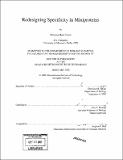| dc.contributor.advisor | Amy E. Keating. | en_US |
| dc.contributor.author | Taylor, Christina Marie | en_US |
| dc.contributor.other | Massachusetts Institute of Technology. Dept. of Biology. | en_US |
| dc.date.accessioned | 2008-02-28T16:21:55Z | |
| dc.date.available | 2008-02-28T16:21:55Z | |
| dc.date.copyright | 2006 | en_US |
| dc.date.issued | 2006 | en_US |
| dc.identifier.uri | http://dspace.mit.edu/handle/1721.1/34192 | en_US |
| dc.identifier.uri | http://hdl.handle.net/1721.1/34192 | |
| dc.description | Thesis (Ph. D.)--Massachusetts Institute of Technology, Dept. of Biology, 2006. | en_US |
| dc.description | Includes bibliographical references. | en_US |
| dc.description.abstract | This work focuses on designing specific miniprotein interactions using computational models and then testing these designs with experiments. Miniproteins are small, autonomously-folding proteins that are excellent for testing protein designs because they can be chemically synthesized and computationally modeled. Despite their diminutive size, miniproteins are used as minimal models to discern important features, such as folding and interaction specificity, in natural proteins. A 21-residue [beta][beta][alpha] homotetramer miniprotein (BBA) was computationally redesigned to interact as a heterotetramer. Protein design calculations revealed a large/small pattern of hydrophobic residues in the core and charge complementarity on the surface as a mechanism for attaining heterospecificity. Solution studies showed the designed protein is a tetramer and interacts in the same stoichiometry as its parent homotetramer. The x-ray crystal structure of the heterotetramer revealed a structure very close to the designed structure with near-perfect prediction of core side-chain packing. In a second round of design, the BBA heterotetramer was stabilized to near-native stability. Next, the coiled-coil region within the Bcr (breakpoint cluster region) oligomerization domain was used to probe antiparallel versus parallel helix-orientation specificity in coiled coils. | en_US |
| dc.description.abstract | (cont.) Based on the Bcr sequence, it is unclear why the oligomerization domain has an antiparallel orientation preference. The isolated Bcr coiled-coil region adopts an antiparallel orientation, so the orientation preference must be encoded in the Bcr coiled-coil sequence itself. Coiled-coil statistics and parallel and antiparallel model structures revealed an alanine and glutamate in the Bcr core as candidates that may be important for helix-orientation specificity. Both residues were mutated to leucine, a common core residue in parallel coiled coils. Based on solution studies of the mutant, both alanine and glutamate play an important role in oligomerization specificity, while glutamate may also be important for orientation specificity in Bcr. Finally, interaction partners to the Bcr oligomerization domain were computationally designed to act as dominant negative inhibitors. Four interaction partners were designed using different design techniques and energy functions. The inhibitors were expressed in E. coli and tested in a pull-down assay. | en_US |
| dc.description.statementofresponsibility | by Christina Marie Taylor. | en_US |
| dc.format.extent | 255 p. | en_US |
| dc.language.iso | eng | en_US |
| dc.publisher | Massachusetts Institute of Technology | en_US |
| dc.rights | M.I.T. theses are protected by copyright. They may be viewed from this source for any purpose, but reproduction or distribution in any format is prohibited without written permission. See provided URL for inquiries about permission. | en_US |
| dc.rights.uri | http://dspace.mit.edu/handle/1721.1/34192 | en_US |
| dc.rights.uri | http://dspace.mit.edu/handle/1721.1/7582 | |
| dc.subject | Biology. | en_US |
| dc.title | Redesigning specificity in miniproteins | en_US |
| dc.type | Thesis | en_US |
| dc.description.degree | Ph.D. | en_US |
| dc.contributor.department | Massachusetts Institute of Technology. Department of Biology | |
| dc.identifier.oclc | 69651861 | en_US |
